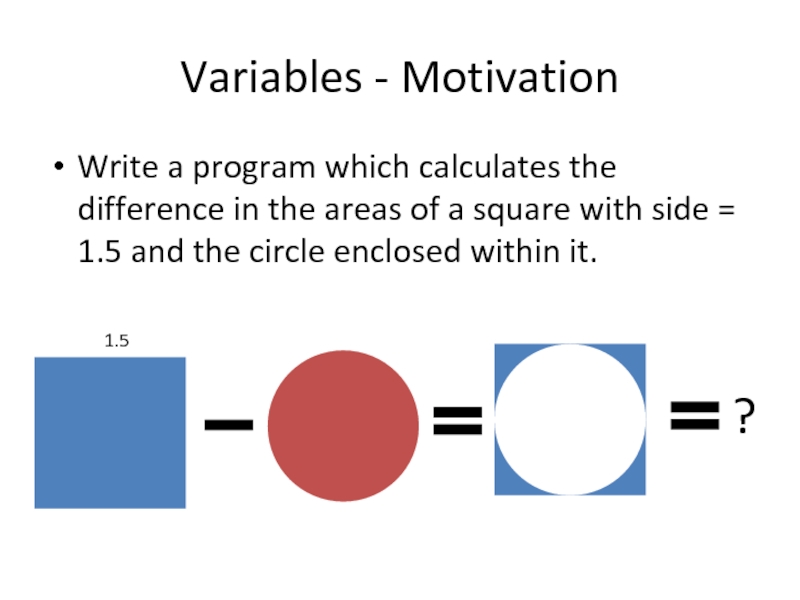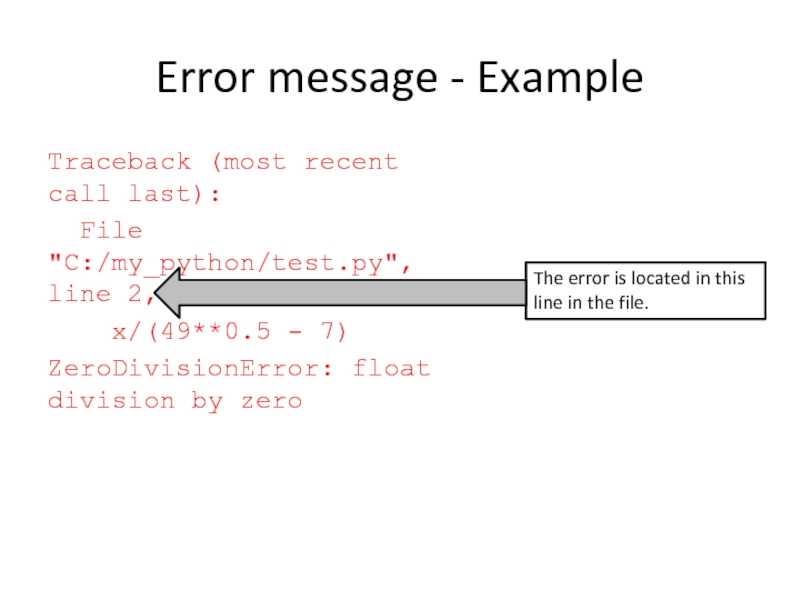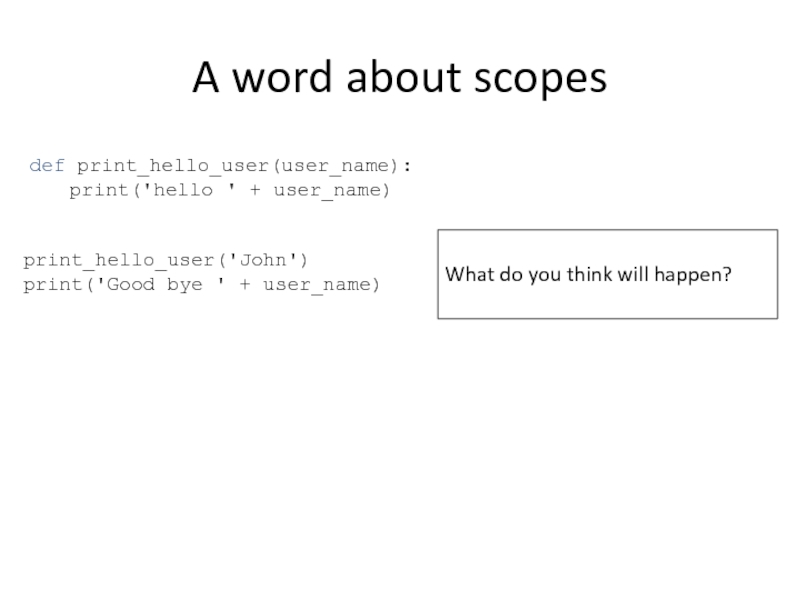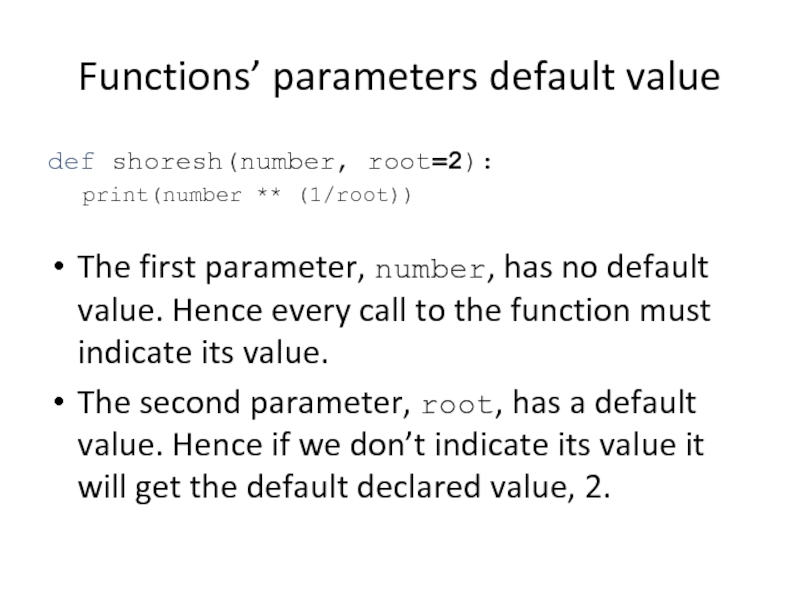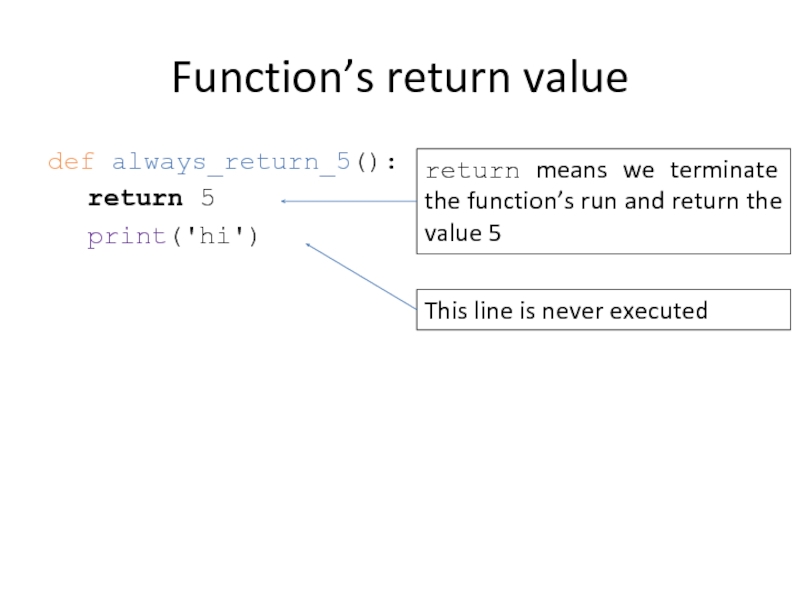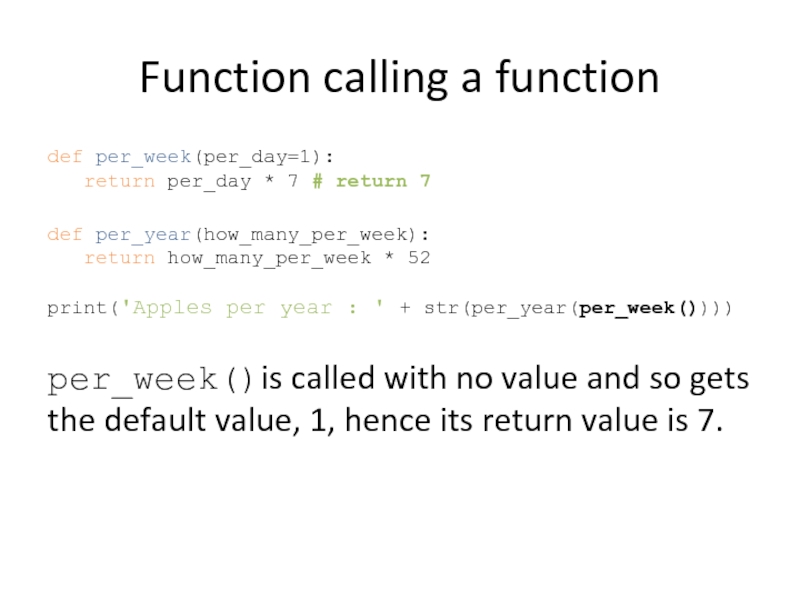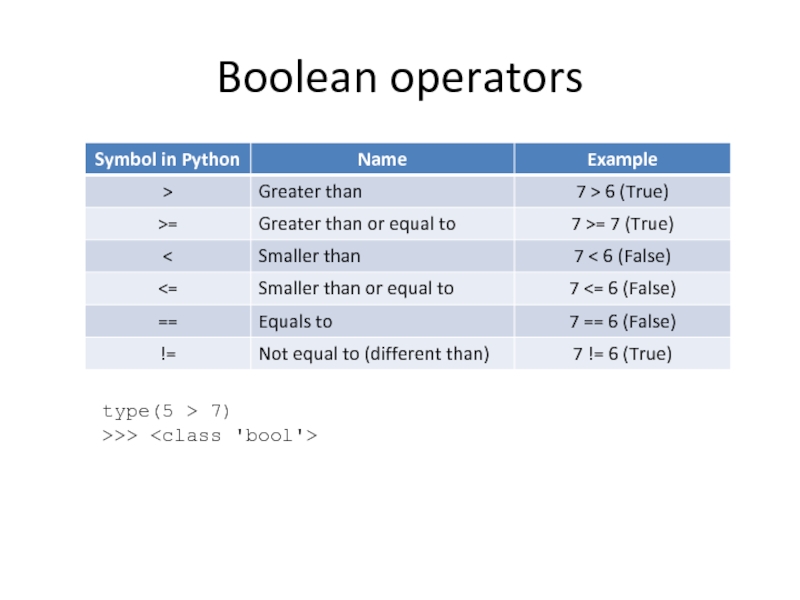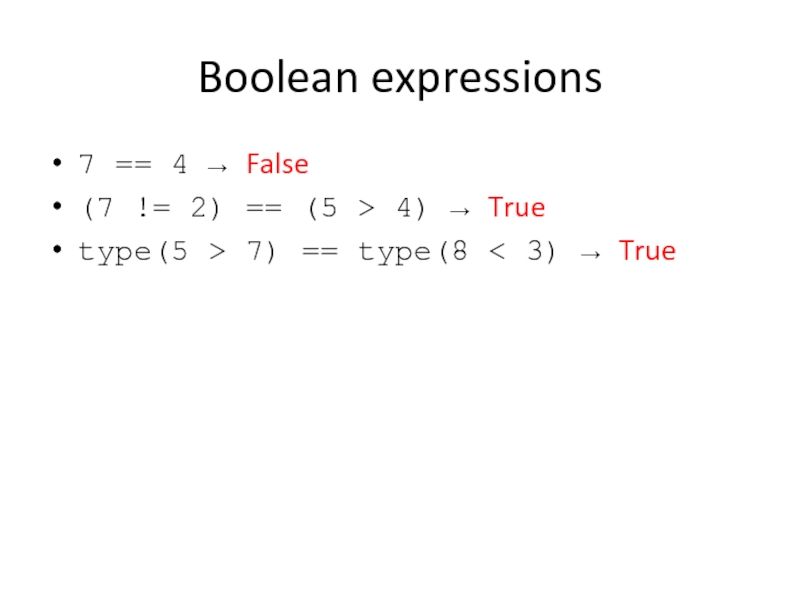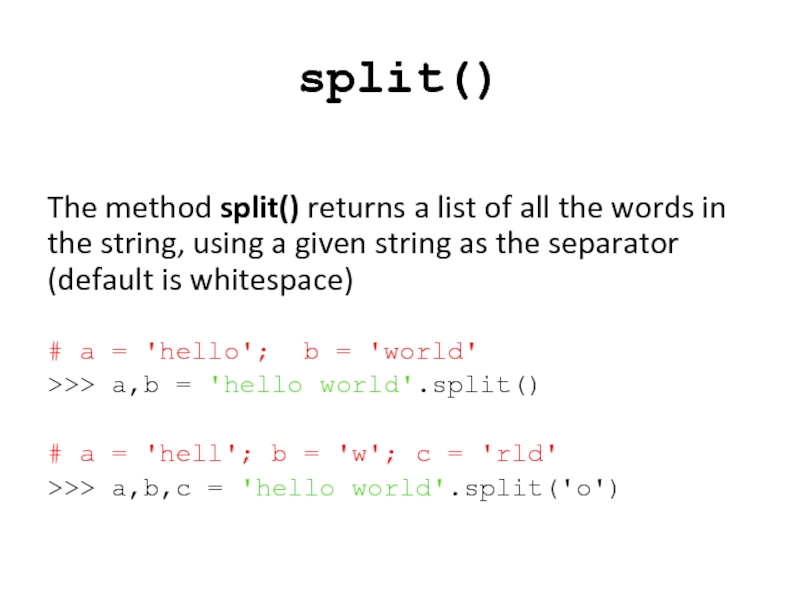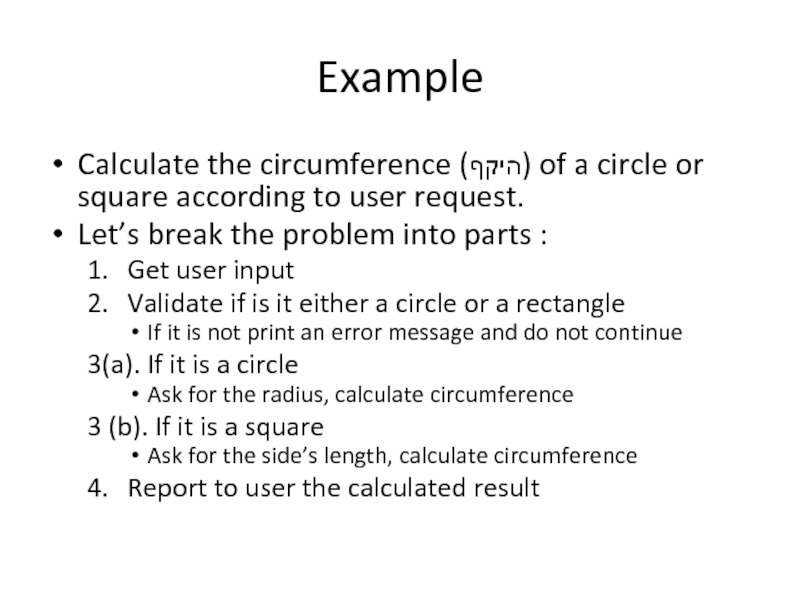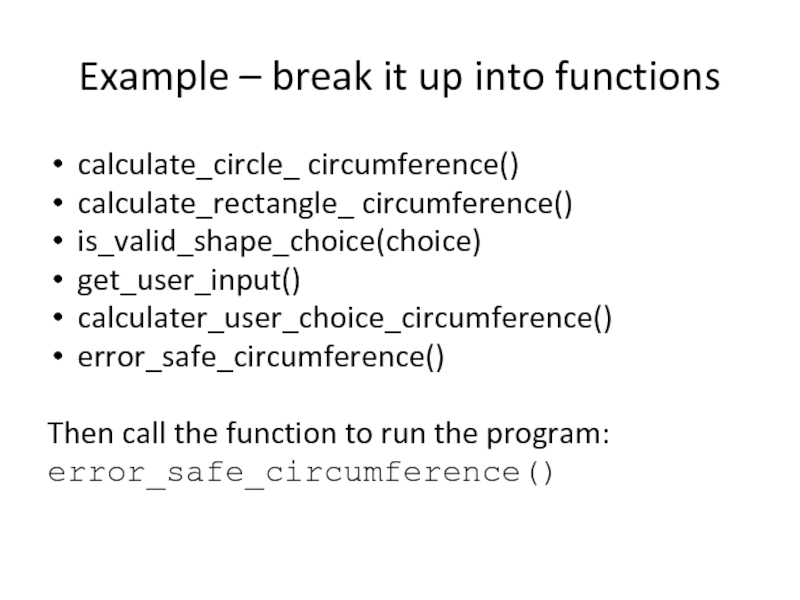- Главная
- Разное
- Дизайн
- Бизнес и предпринимательство
- Аналитика
- Образование
- Развлечения
- Красота и здоровье
- Финансы
- Государство
- Путешествия
- Спорт
- Недвижимость
- Армия
- Графика
- Культурология
- Еда и кулинария
- Лингвистика
- Английский язык
- Астрономия
- Алгебра
- Биология
- География
- Детские презентации
- Информатика
- История
- Литература
- Маркетинг
- Математика
- Медицина
- Менеджмент
- Музыка
- МХК
- Немецкий язык
- ОБЖ
- Обществознание
- Окружающий мир
- Педагогика
- Русский язык
- Технология
- Физика
- Философия
- Химия
- Шаблоны, картинки для презентаций
- Экология
- Экономика
- Юриспруденция
Basic programming презентация
Содержание
- 1. Basic programming
- 2. Overview Variables Types : int, float, string
- 3. Variables - Motivation Write a program which
- 4. Variables - Motivation 1.5*1.5 –3.14*(1.5/2 )**2 Area
- 5. Variables - Motivation Two problems :
- 6. Variables - Motivation Wouldn’t it be much
- 7. Variables Variables let us define “memory units”
- 8. Variables Variables have 2 main functionalities :
- 9. Variables – Naming conventions Use lower case
- 10. Types Can we perform the following command
- 11. Types int (Integer) : represent an Integer
- 12. Types The type() function receives a value
- 13. Types What happens when we mix types?
- 14. Error message Error messages are our friends,
- 15. Error message - Example >>> x =
- 16. Error message - Example Traceback (most recent
- 17. Error message - Example Traceback (most recent
- 18. Error message - Example Traceback (most recent
- 19. Error message - Example Traceback (most recent
- 20. Error message - Example Traceback (most recent
- 21. Error message - Example Traceback (most recent
- 22. But what if we do want to
- 23. Converting types (casting) int, float and str
- 24. Converting types – int(),float() Converts string representing
- 25. User input To make a program interactive
- 26. User input - Example square_side = input('Insert
- 27. User input - Example area
- 28. User input - Example square_side = float(input('Insert
- 29. Functions with input def function_name(param1, param2,…,paramN): #indented
- 30. Functions with input When we call a
- 31. Functions with input def print_hello_user(user_name): print('hello '
- 32. Functions with input def print_hello_user(user_name): print('hello '
- 33. Functions with input def print_hello_user(user_name): print('hello '
- 34. A word about scopes def print_hello_user(user_name): print('hello
- 35. A word about scopes def print_hello_user(user_name): print('hello
- 36. A word about scopes ROOT = 2
- 37. A word about scopes x = 2
- 38. A function with more than 1 input
- 39. Functions’ parameters default value Sometimes …. A
- 40. Functions’ parameters default value def shoresh(number, root=2):
- 41. Functions’ parameters default value def shoresh(number, root=2):
- 42. Function’s return value Many times we want
- 43. Function’s return value def always_return_5(): return 5
- 44. Function’s return value def always_return_5(): return 5
- 45. Function calling a function We can use
- 46. Function calling a function def per_week(per_day=1):
- 47. Function calling a function def per_week(per_day=1):
- 48. Function calling a function We can use
- 49. Multiple outputs functions To return more than
- 50. None None is a special value which
- 51. None - example def print_hi():
- 52. The Boolean type Like int, str and
- 53. Boolean expressions Boolean expressions are expressions which
- 54. Boolean operators type(5 > 7) >>>
- 55. Boolean expressions 7 == 4 → ?
- 56. Boolean expressions 7 == 4 → False
- 57. Complex Boolean operators Take few Boolean operators
- 58. Complex Boolean operators Truth table
- 59. Conditional operation We do not always want
- 60. Conditional operation - if How do we
- 61. Conditional operation - if For example :
- 62. Conditional operation - if num = float(input('Insert
- 63. Conditional operation - else num = float(input('Insert
- 64. Conditional operation - elif And what if
- 65. Conditional operation - elif if now ==
- 66. Nested if What operations could be included
- 67. Nested if - example if now ==
- 68. Nested if - example if now ==
- 69. split() The method split() returns a
- 70. Example Calculate the circumference (היקף) of a
- 71. Example – break it up into functions
- 72. PI = 3.14 CHOICE_CIRCLE = 'C'
- 73. def calculate_circumference(shape): # runs 5’th
- 74. Summary Today we have learned : How
Слайд 2Overview
Variables
Types : int, float, string
User input
Functions with input and output
The Boolean
Conditional operation (if…else…)
Слайд 3Variables - Motivation
Write a program which calculates the difference in the
?
1.5
Слайд 5Variables - Motivation
Two problems :
The expression 1.5*1.5 –3.14*(1.5/2 )**2
is
When you get back to it after one week
When debugging
When the side of the square changes. Should you have an expression per side-length?
Side=1.5 : 1.5*1.5 – 3.14*(1.5/2 )**2
Side=3.7 : 3.7*3.7 – 3.14*(3.7/2 )**2
Side=9 : 9*9 – 3.14*(9/2) )**2
Слайд 6Variables - Motivation
Wouldn’t it be much more readable, modular, easy to
side = 1.5, PI = 3.14
square_area = side*side
radius = side/2
circle_area = PI*r2
answer = square_area – circle_area
Слайд 7Variables
Variables let us define “memory units” which can “remember” values.
Variables have
name
value
Value :
3
This is a variable
Name :
number_of_apples
Слайд 8Variables
Variables have 2 main functionalities :
Set their value
number_of_apples =
Get their values
tomorrow_apples = number_of_apples + 1
number_of_apples
tomorrow apples
3
Set
Get
Set
+ 1
Слайд 9Variables – Naming conventions
Use lower case letter
number,apples
Separate multiple words with underscore
word_and_more_words
Use
z = x/y ???
words_per_page = words_in_book/number_of_pages ☺
Use capitals for constants (variables which do not change their value after first initialization)
PI = 3.14, ERROR_MESSAGE = ‘You had an error’
Слайд 10Types
Can we perform the following command ?
x = 3 +
And this one ?
x = 3 + “hello”
Why not? 3 and ‘hello’ are not of the same category. The name Python gives to the categories which differentiate between objects such as 3 and ‘hello’ are called type.
Слайд 11Types
int (Integer) : represent an Integer number (מספר שלם).
E.g. 1024,
float : represent a fractional number.
E.g. : 0.0, 15.62545, 3.14
str (String) : represent text, a list of characters. Defined between a couple of apostrophe or quotes (equivalent).
E.g. ‘hello’, “hello”, ‘13’
Слайд 12Types
The type() function receives a value and return its type.
type(3) →
type(3.0) → float
type('3.0') → str
What happens when we mix types?
type(1 + 0.5) → float
type(1 + 'some string') → ?
Слайд 13Types
What happens when we mix types?
type(1 + 'some string')
TypeError: unsupported operand
This is an error message which tells us we have tried to execute a command not supported by the language.
Слайд 14Error message
Error messages are our friends, they help us detect bugs
When you get an error “keep calm and read the error message”.
Слайд 15Error message - Example
>>> x = 49
>>> x/(49**0.5 - 7)
Traceback (most
File "C:/my_python/test.py", line 9, in
x/(49**0.5 - 7)
ZeroDivisionError: float division by zero
Remember - “keep calm and read the error message”
Слайд 16Error message - Example
Traceback (most recent call last):
File "C:/my_python/test.py", line
x/(49**0.5 - 7)
ZeroDivisionError: float division by zero
The error occurred when we ran the program saved at this file.
Слайд 17Error message - Example
Traceback (most recent call last):
File "C:/my_python/test.py", line
x/(49**0.5 - 7)
ZeroDivisionError: float division by zero
The error is located in this line in the file.
Слайд 18Error message - Example
Traceback (most recent call last):
File "C:/my_python/test.py", line
x/(49**0.5 - 7)
ZeroDivisionError: float division by zero
The command which caused the trouble was this.
Слайд 19Error message - Example
Traceback (most recent call last):
File "C:/my_python/test.py", line
x/(49**0.5 - 7)
ZeroDivisionError: float division by zero
The error itself is of type Zero division
Слайд 20Error message - Example
Traceback (most recent call last):
File "C:/my_python/test.py", line
x/(49**0.5 - 7)
ZeroDivisionError: float division by zero
And it happened because we have tried to divide a float by 0
Слайд 21Error message - Example
Traceback (most recent call last):
File "C:/my_python/test.py", line
x/(49**0.5 - 7)
ZeroDivisionError: float division by zero
No matter what, you are going to have bugs. Error messages make the debugging process much more productive.
With time, you’ll meet more types of errors and you’ll get better in understanding their meaning, locating your bugs and fixing them.
Слайд 22But what if we do want to mix types?
my_apples = 3
print('I
TypeError: Can't convert 'int' object to str implicitly
The error message tells us we have tried to convert an int to a str but we cannot do this implicitly.
So let’s do it explicitly.
Слайд 23Converting types (casting)
int, float and str are not only names of
Example :
str(5) → '5'
float(5) → 5.0
int('5') → 5
Слайд 24Converting types – int(),float()
Converts string representing numbers to the represented numbers
int('5')→5
Cannot
int('5.5'), int('Hello')
Converts float to int by rounding the number down.
int(5.9)→5
Converts string representing numbers to the represented numbers
float('5.5')→5.5
Cannot convert strings not representing a float:
float('Hello')
Converts int to float by treating it as a round number.
float(5)→5.0
Слайд 25User input
To make a program interactive we can ask the user
The function input(s) :
Prints to the screen s
Halts the program execution and waits for the user to insert some input and press enter
Return a string representing the user’s input
Слайд 26User input - Example
square_side = input('Insert side length: ')
# Wait
3
- The value of square_side is 3
area = square_side * square_side
Will this work?
Слайд 27User input - Example
area = square_side * square_side
'3'*'3'
TypeError: can't multiply
Input returns a string, and we can’t multiply string by string. So what do we do? Convert types
Слайд 28User input - Example
square_side = float(input('Insert side length: '))
# Wait for
3
area = square_side * square_side
The value of area is 9.0
Слайд 29Functions with input
def function_name(param1, param2,…,paramN):
#indented code is here
#as usual
The name of
Слайд 30Functions with input
When we call a function with input parameters, we
Слайд 31Functions with input
def print_hello_user(user_name):
print('hello ' + user_name)
print_hello_user('John')
Function definition
Function body (implementation)
Function call
Слайд 32Functions with input
def print_hello_user(user_name):
print('hello ' + user_name)
print_hello_user('John')
1) When we call the
2) The function parameter (user_name) is assigned the value with which the function was called ('John')
3) We can use user_name inside the function and it will have the value with which the function was called
Слайд 33Functions with input
def print_hello_user(user_name):
print('hello ' + user_name)
print_hello_user('John')
>>> hello John
print_hello_user('Doe')
Слайд 34A word about scopes
def print_hello_user(user_name):
print('hello ' + user_name)
print_hello_user('John')
print('Good bye ' +
What do you think will happen?
Слайд 35A word about scopes
def print_hello_user(user_name):
print('hello ' + user_name)
print_hello_user('John')
print('Good bye ' +
NameError: name ‘user_name' is not defined
The parameter user_name is defined at the function print_hello_user and hence it is not known outside the scope of the function.
Слайд 36A word about scopes
ROOT = 2
def square_root(number):
print(number**(1/ROOT))
square_root(4)
>>> 2.0
A new
Here, ROOT is defined in the general scope hence the function which opens a new scope, still knows the value of ROOT.
Слайд 37A word about scopes
x = 2
def example():
x = 5
example()
print(x)
>>> 5 # When in the function, a new scope is defined, and the new variable x shadows the definition of the x from upper scope.
>>> 2 # When exiting the function’s scope, the scope of the function is not regarded any more hence the x of the outer scope kicks in.
However, this is confusing and considered bad style. To avoid confusions of the sort, pick unique variable names across scopes.
Слайд 38A function with more than 1 input
def get_details(name, password):
print('Name is :'
get_details('John', '1234')
Q: How does the function knows which value goes where (that name is John and password is 1234 and not the other way around).
A: According to variables order.
Слайд 39Functions’ parameters default value
Sometimes ….
A function has an obvious use case
You have prepared a good option for the user but don’t want to force her to use it
In such cases, you can define a default value to the function’s parameters. A value that will be used if no other value is specified.
Слайд 40Functions’ parameters default value
def shoresh(number, root=2):
print(number ** (1/root))
The first parameter, number,
The second parameter, root, has a default value. Hence if we don’t indicate its value it will get the default declared value, 2.
Слайд 41Functions’ parameters default value
def shoresh(number, root=2):
print(number ** (1/root))
shoresh(64) # Here we
>> 8
shoresh(64, 3) # Here we indicated the second variable, hence its value was used and not the default
>> 4
Слайд 42Function’s return value
Many times we want functions to not only perform
Using the return keyword, a function is able to return a value.
Слайд 43Function’s return value
def always_return_5():
return 5
print('hi')
return means we terminate the function’s run
This line is never executed
Слайд 44Function’s return value
def always_return_5():
return 5
print('hi')
print(3 + always_return_5())
>>> 8
The function returns the
Слайд 45Function calling a function
We can use the return value of one
def per_week(per_day=1): return per_day * 7
def per_year(how_many_per_week): return how_many_per_week * 52 print('Apples per year : ' + str(per_year(per_week())))
What happens here?
Слайд 46Function calling a function
def per_week(per_day=1):
return per_day * 7 #
def per_year(how_many_per_week): return how_many_per_week * 52 print('Apples per year : ' + str(per_year(per_week())))
per_week()is called with no value and so gets the default value, 1, hence its return value is 7.
Слайд 47Function calling a function
def per_week(per_day=1):
return per_day * 7 #
def per_year(how_many_per_week): return how_many_per_week * 52 # return 364 print('Apples per year : ' + str(per_year(7)))
per_year()is called with the value 7 and so returns the value 364
Слайд 48Function calling a function
We can use the return value of one
def per_week(per_day =1): return per_day * 7 # return 7
def per_year(how_many_per_week): return how_many_per_week * 52 # return 364 print('Apples per year : ' + str(per_year(7)))
>>> Apples per year : 364
Слайд 49Multiple outputs functions
To return more than one value, separate return values
def diff_and_ratio(num1, num2):
return num1-num2, num1/num2
diff, ratio = diff_and_ratio(1, 5)
print(diff)
print(ratio)
Слайд 50None
None is a special value which is used to represent absence
Every function which does not return value explicitly, return None implicitly.
Слайд 51None - example
def print_hi():
print('hi')
x = print_hi() # x is
print(x)
>>>hi
>>>None
Слайд 52The Boolean type
Like int, str and float , Boolean is another
Boolean can get only one of two values :
True
False
type(True)
>>>
Слайд 53Boolean expressions
Boolean expressions are expressions which use Boolean operators to evaluate
For example > is a Boolean operator. Its Boolean evaluation is “Is the object on the right larger than the object on the left?”
5 > 7 is a Boolean expression because it uses a Boolean operator. Its value is False.
Слайд 56Boolean expressions
7 == 4 → False
(7 != 2) == (5 >
type(5 > 7) == type(8 < 3) → True
Слайд 57Complex Boolean operators
Take few Boolean operators and evaluate a new Boolean
and and or evaluate 2 Boolean expressions
not evaluates 1 Boolean expression
The return value of complex Boolean operators could be represented in a Truth table – a table that lists al the combination of truth value of input variables and their evaluated output
Слайд 59Conditional operation
We do not always want to execute all the lines
For example : Divide 9 by user’s input.
We get the number from the user.
Only if the number is different than 0, we can divide 9 by it.
Слайд 60Conditional operation - if
How do we implement this notion in Python?
if
#Code to perform if the #boolean_expression is True
#(Note the indentation under the if
#block).
Слайд 61Conditional operation - if
For example :
num = float(input('Insert a number‘))
if
print(9/num)
But what if the number does equal 0? We still want to let the user know.
Слайд 62Conditional operation - if
num = float(input('Insert a number'))
if num != 0
print(9/num)
if num == 0 :
print('Cannot divide by 0')
This is not a natural way to present our intention. What we would usually say is : if the number is different than 0 divide, else print some message to the user.
Python lets us use such structure using the else keyword.
Слайд 63Conditional operation - else
num = float(input('Insert a number'))
if num != 0
print(9/num)
else:
print('Cannot divide by 0')
else should appear directly under an if block with the same indention.
Слайд 64Conditional operation - elif
And what if we had some more options
If condition1 then result1,
if not, than if condition2 then result2
…
if not, than if conditionN then resultN
If none of the above then result_Final
Use elif! (=else if)
Слайд 65Conditional operation - elif
if now == 'Morning':
print('Good morning!')
elif now
print('Good noon')
else:
print('It must be evening')
The first elif should appear directly under an if block with the same indention.
As many elif’s as you wish can follow.
elif can be terminated by a single else, or not at all.
Слайд 66Nested if
What operations could be included inside an if block? Any
input
… and – another if!
An if inside another if is called nested if – it opens a new block with its own indentation.
Слайд 67Nested if - example
if now == 'morning':
if 'y' ==
print('Bon appetit!')
else:
print('Some other time than')
elif now == 'Noon':
print('Good noon')
else:
print('Good night')
Слайд 68Nested if - example
if now == 'morning':
if 'y' ==
print('Bon appetit!')
else:
print('Some other time than')
elif now == 'Noon':
print('Good noon')
else:
print('Good night')
This if is nested inside this
one
Слайд 69split()
The method split() returns a list of all the words in
# a = 'hello'; b = 'world'
>>> a,b = 'hello world'.split()
# a = 'hell'; b = 'w'; c = 'rld'
>>> a,b,c = 'hello world'.split('o')
Слайд 70Example
Calculate the circumference (היקף) of a circle or square according to
Let’s break the problem into parts :
1. Get user input
2. Validate if is it either a circle or a rectangle
If it is not print an error message and do not continue
3(a). If it is a circle
Ask for the radius, calculate circumference
3 (b). If it is a square
Ask for the side’s length, calculate circumference
4. Report to user the calculated result
Слайд 71Example – break it up into functions
calculate_circle_ circumference()
calculate_rectangle_ circumference()
is_valid_shape_choice(choice)
get_user_input()
calculater_user_choice_circumference()
error_safe_circumference()
Then call the
error_safe_circumference()
Слайд 72PI = 3.14
CHOICE_CIRCLE = 'C'
CHOICE_RECTANGLE = 'R'
MESSAGE_INPUT_REQUEST = 'Choose shape(C,R): '
MESSAGE_OUTPUT_REPORT
MESSGAE_INSTRUCTIONS = 'This program calculate the circumference of either a circle or a square'
MESSGAE_RADIUS_REQUEST = 'Insert circle radius: '
MESSGAE_SIDE_REQUEST = 'Insert length of side: '
ERROR_NO_SUCH_SHAPE = 'No such shape'
def calculate_circle_circumference(): # runs 6’th (opt. 1)
return 2*PI*float(input(MESSGAE_RADIUS_REQUEST))
def calculate_rectangle_circumference(): # runs 6’th (opt. 2)
return 4*float(input(MESSGAE_SIDE_REQUEST))
def get_user_input(): # runs 3’rd
print(MESSGAE_INSTRUCTIONS)
return input(MESSAGE_INPUT_REQUEST)
Слайд 73def calculate_circumference(shape): # runs 5’th
if shape == CHOICE_CIRCLE :
elif shape == CHOICE_RECTANGLE:
return calculate_rectangle_circumference()
def is_valid_shape_choice(choice): # runs 4’th
return (choice == CHOICE_CIRCLE) or (choice == CHOICE_RECTANGLE)
def calculater_user_choice_circumference(): # runs 2’nd
user_choice = get_user_input()
if not is_valid_shape_choice(user_choice):
return None
else:
circumference = calculate_circumference(user_choice)
return circumference
def error_safe_circumference(): # this function runs 1’st
circumference = calculater_user_choice_circumference()
if circumference == None:
print(ERROR_NO_SUCH_SHAPE)
else:
print(MESSAGE_OUTPUT_REPORT + str(circumference))
Слайд 74Summary
Today we have learned :
How to use variable
What are types and
How to receive an input from a user
How to use functions which get input and return output
Conditional operation : if, elif, else


